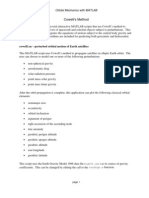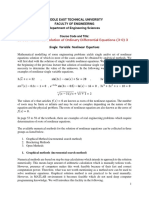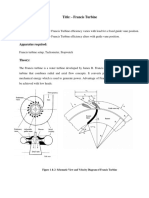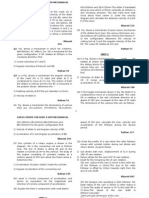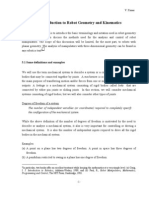ME685A: Applied Numerical Methods Homework Assignment #1 Maximum Marks: 20
Uploaded by
princeME685A: Applied Numerical Methods Homework Assignment #1 Maximum Marks: 20
Uploaded by
princeDepartment of Mechanical Engineering
Indian Institute of Technology Kanpur
ME685A: Applied Numerical Methods
Homework Assignment #1
Maximum Marks: 20
1. A parachutist of mass 68.1 kg jumps out of a stationary hot air balloon. As discussed in the class,
the method of calculus is used to obtain the analytical solution (exact solution) to the problem of
finding the velocity of the parachutist as a function of time. This expression is given by the following
equation:
𝑔𝑚 𝑐
𝑣(𝑡) = (1 − 𝑒 −(𝑚)𝑡 )
𝑐
The drag coefficient ‘c’ is given to be equal to 12.5 kg/s. The acceleration due to gravity ‘g’ is 9.8
m/s2.
Part 1:
Use the above equation to calculate the velocity as a function of time analytically from time t = 0 s to
time t = infinity. (note that you have to choose a higher value for time to represent ‘infinity’). Use a
time interval of 2 s. Plot a graph between time (along the x axis) and velocity (along the y axis) to
represent the way velocity changes with respect to time.
Part 2:
Derive an expression using the forward difference and obtain the finite divided difference
approximation for velocity. The approach adopted is called the Euler Method. Using this derived
expression, obtain the velocities at different times for a step-size of 2 s. Plot the variation of velocity
with time, as before on a graph, and superimpose the earlier graph to understand the difference
between analytical and numerical solution for the problem.
(Note: Hand-drawn graphs will receive zero marks; you may use Microsoft Excel, Matlab, or any
suitable software for computer calculation and plotting graphs).
(Total for Question 1: 10 Marks)
2. Using zero, first, second and third-order Taylor series expansion, predict f (3) for the following
function, 𝑓(𝑥) = 25𝑥 3 − 6𝑥 2 + 7𝑥 − 88 using a base point at x = 1. Compute the true percent
relative error (εt) for each approximation.
(10 Marks)
END OF ASSIGNMENT
You might also like
- Cowell's Method: Cowell1.m - Perturbed Orbital Motion of Earth SatellitesNo ratings yetCowell's Method: Cowell1.m - Perturbed Orbital Motion of Earth Satellites25 pages
- 2024 12MAM App Task Component 1 Final - SolutionsNo ratings yet2024 12MAM App Task Component 1 Final - Solutions8 pages
- A New Optimal Iterative Algorithm For Solving NonlNo ratings yetA New Optimal Iterative Algorithm For Solving Nonl7 pages
- KT 14503 Mathematics For Computing Group Assignment 20 MarksNo ratings yetKT 14503 Mathematics For Computing Group Assignment 20 Marks7 pages
- Computer Aided Process Engineering LaboratoryNo ratings yetComputer Aided Process Engineering Laboratory3 pages
- November 3, 2009 Not For Submission: Indian Institute of Technology Kanpur Department of Mechanical EngineeringNo ratings yetNovember 3, 2009 Not For Submission: Indian Institute of Technology Kanpur Department of Mechanical Engineering1 page
- Numerical Solution of Ordinary Differential Equations Part 2 - Nonlinear EquationsNo ratings yetNumerical Solution of Ordinary Differential Equations Part 2 - Nonlinear Equations38 pages
- 1154 MATH F313 20221227084943 Comprehensive Exam Question Paper-2No ratings yet1154 MATH F313 20221227084943 Comprehensive Exam Question Paper-22 pages
- Programming Fundamentals (CS1002) : Assignment 4 (125 Marks) + 10 Bonus MarksNo ratings yetProgramming Fundamentals (CS1002) : Assignment 4 (125 Marks) + 10 Bonus Marks5 pages
- TBD2A.assignment.3 .U28.Ausama.2012.Border&Qs.No ratings yetTBD2A.assignment.3 .U28.Ausama.2012.Border&Qs.8 pages
- Assignment 4_9c1ff867-2368-4c16-8b4b-5adfbd043c28No ratings yetAssignment 4_9c1ff867-2368-4c16-8b4b-5adfbd043c282 pages
- Some Efficient Heuristic Methods For The Flow Shop Sequencing ProblemNo ratings yetSome Efficient Heuristic Methods For The Flow Shop Sequencing Problem21 pages
- Civil & Environmental Engineering Department CE318 Numerical & Statistical Methods in Civil Engineering (132) Lab Assignment #2No ratings yetCivil & Environmental Engineering Department CE318 Numerical & Statistical Methods in Civil Engineering (132) Lab Assignment #23 pages
- Chap10 ENGINEERING APPLICATION (L - Week 14)No ratings yetChap10 ENGINEERING APPLICATION (L - Week 14)12 pages
- Muhamad Hilman Mutaqin N_13121204_Traction&Rolling ResistanceNo ratings yetMuhamad Hilman Mutaqin N_13121204_Traction&Rolling Resistance8 pages
- A Brief Introduction to MATLAB: Taken From the Book "MATLAB for Beginners: A Gentle Approach"From EverandA Brief Introduction to MATLAB: Taken From the Book "MATLAB for Beginners: A Gentle Approach"2.5/5 (2)
- Research Article: Nonlinear Mathematical Modeling in Pneumatic Servo Position ApplicationsNo ratings yetResearch Article: Nonlinear Mathematical Modeling in Pneumatic Servo Position Applications17 pages
- Solutions: ESC101A: Fundamentals of Computing (End Semester Exam - A)No ratings yetSolutions: ESC101A: Fundamentals of Computing (End Semester Exam - A)25 pages
- Quantity 2 Nos. of Teeth (N) 30 Module (M) 2 Outer Diameter (OD) 62mm Depth of Cut 2.157 X M Tap Hole Size 5.2 MM Drill & " Tapping Indexing CalculationNo ratings yetQuantity 2 Nos. of Teeth (N) 30 Module (M) 2 Outer Diameter (OD) 62mm Depth of Cut 2.157 X M Tap Hole Size 5.2 MM Drill & " Tapping Indexing Calculation1 page
- The Ascending Double-Cone - A Closer Look at A Familiar Demonstration100% (1)The Ascending Double-Cone - A Closer Look at A Familiar Demonstration16 pages
- Properties of Solutions: Theodore L. Brown H. Eugene Lemay, Jr. and Bruce E. BurstenNo ratings yetProperties of Solutions: Theodore L. Brown H. Eugene Lemay, Jr. and Bruce E. Bursten71 pages
- Material Selection - Manufacturing ProcessNo ratings yetMaterial Selection - Manufacturing Process31 pages
- Units and Measurement _ DPP 05 __ Arjuna NEET 2.0 2025No ratings yetUnits and Measurement _ DPP 05 __ Arjuna NEET 2.0 20253 pages
- GS02-1093 - Introduction To Medical Physics I Basic Interactions Problem Set 2.2 SolutionsNo ratings yetGS02-1093 - Introduction To Medical Physics I Basic Interactions Problem Set 2.2 Solutions6 pages
- Optically Detected Magnetic Resonance in HBN DefectNo ratings yetOptically Detected Magnetic Resonance in HBN Defect9 pages
- 1999 - Brummer and Godersky - Rheological Studies To Objectify Sensations Occurring When Cosmetic Emulsions Are Applied To The SkinNo ratings yet1999 - Brummer and Godersky - Rheological Studies To Objectify Sensations Occurring When Cosmetic Emulsions Are Applied To The Skin6 pages
- Physical and Chemical Stability and Excipient CompatibilityNo ratings yetPhysical and Chemical Stability and Excipient Compatibility12 pages
- ECE/CS 559 - Neural Networks Lecture Notes #8: Associative Memory and Hopfield NetworksNo ratings yetECE/CS 559 - Neural Networks Lecture Notes #8: Associative Memory and Hopfield Networks9 pages
- Classical Mechanics 2nd Edition Tai L. Chow 2024 scribd downloadNo ratings yetClassical Mechanics 2nd Edition Tai L. Chow 2024 scribd download41 pages
- 270-On The Dynamics in Space of Rods Undergoing Large Motions - A Geometrically Exact ApproachNo ratings yet270-On The Dynamics in Space of Rods Undergoing Large Motions - A Geometrically Exact Approach37 pages

